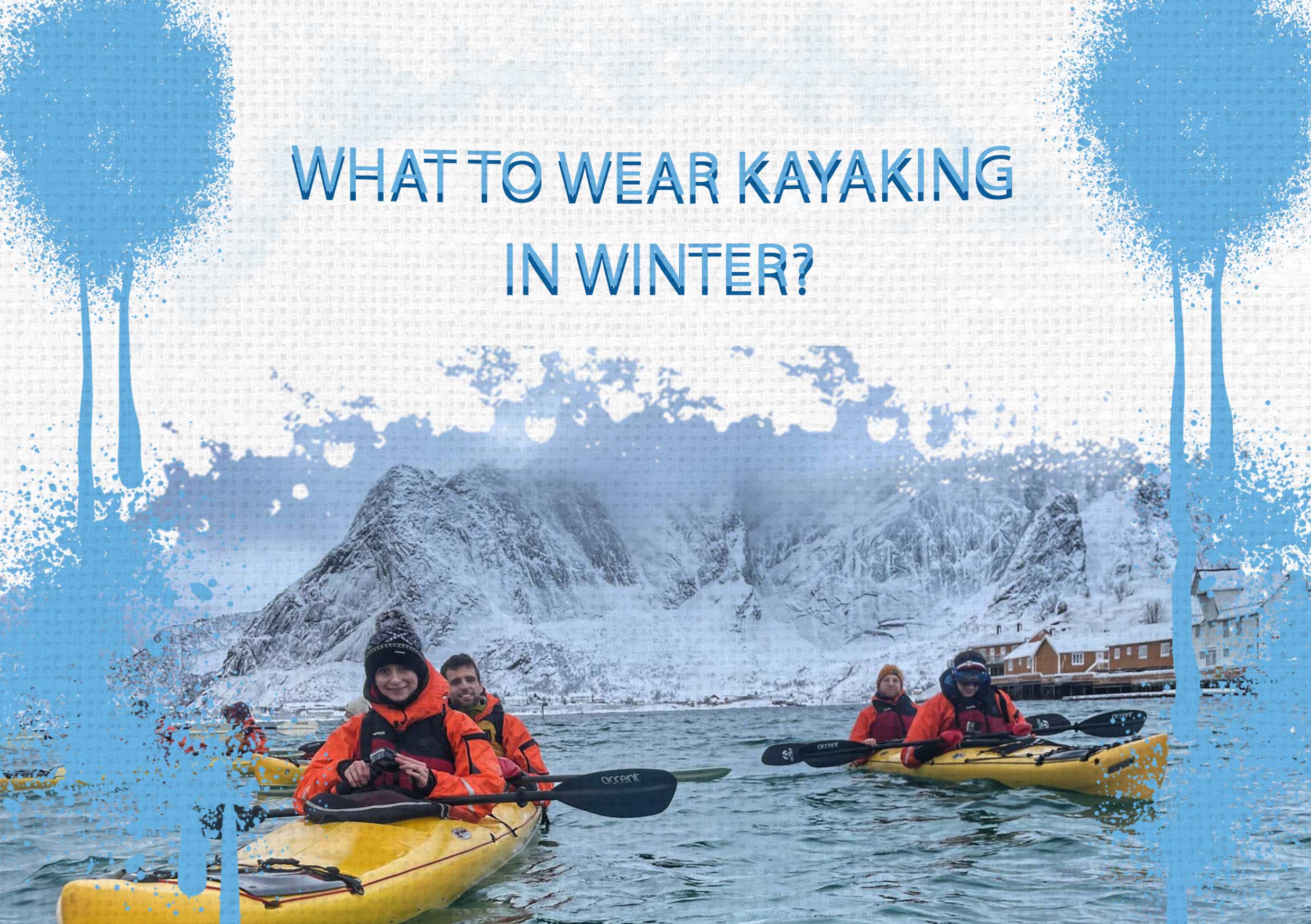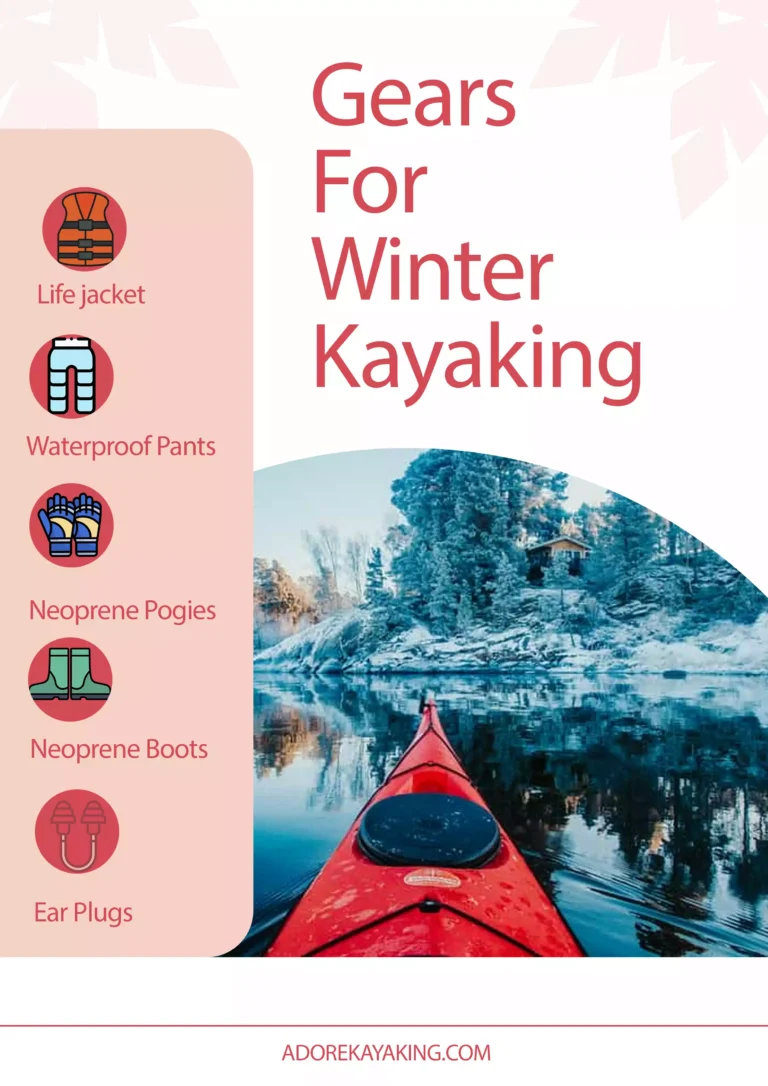
Kayaking in winter is fun but you have to know what to wear to make sure your trip will be great even in cold weather.
The key to winter kayaking attire is layering with moisture-wicking, insulating, and waterproof materials to keep you dry and warm. From dry suits and wetsuits to neoprene gloves and thermal base layers, choosing the right winter kayaking gear ensures a comfortable and enjoyable adventure on the water.
Bellow the question “what to wear kayaking in winter?” will be answered:
Is it OK to kayak in the winter?
It is OK to kayak in the winter, provided you use suitable winter kayaking gear, monitor weather and water conditions, and follow cold-water safety protocols.
Important winter kayaking gear
This is the complete list of what to wear kayaking in winter:

- Neoprene Pogies and Gloves
- Neoprene Boots
- Kayak bilge pump
- Waterproof Shell Pants
- Inflatable PFDs
- Vest or life jacket with warm cloth underneath
- Moisture Wicking Base Layer
- Wetsuit or dry suit
- Knit, latex, silicone or neoprene cap
- Thick wool or neoprene socks
- paddle mittens
- Kayak Ear Plugs
How should I dress for cold water kayaking?
Dress in layers: a moisture-wicking base layer, insulating mid-layer (such as fleece), and a drysuit as your outer layer. Quality winter kayaking gear also includes neoprene gloves, a warm hat or hood, and insulated booties to retain heat and stay dry.
Base layer
This layer keeps your body away from moisture and stays dry, ensuring you won’t get cold—especially when you’re using cold weather kayak gear. You should wear comfortable clothing, with synthetic fabrics like polypropylene for your inner layer, or opt for merino wool, which provides flexibility, softness, and warmth, similar to a stretchy wetsuit.
Don’t wear cotton, as it holds water and, when wet, makes you heavy and doesn’t keep you warm. It’s better to wear socks to help keep your feet dry and to transfer moisture away from your skin.
Mid layer
this layer’s job is to keep you warm. The heavier merino wool layer and if it gets colder it’s better to wear a synthetic insulation jacket because if it gets wet, still keeps you warm.
Shell for winter kayaking gear
we call this layer, waterproof and windproof. It keeps you away from getting wet or cold and also it removes moisture from the base and mid-layer and protects these layers. In this case, it helps these layers not to make you wet. If you wear a dry suit, that will work for you.
This dry suit is made of a waterproof fabric like gore-tex which has Latex gaskets at the neck, wrist, and ankles. This prevents water from entering to suit. Some dry suits have booties that go into your shoes. Put thicker socks outside the booties to make sure not to damage them.
You can also wear a wetsuit that usually scuba divers use, but a wetsuit is not really recommended to wear for the reasons below. If you have to buy a used dry suit because of it’s high price is much better to wear a wetsuit as winter kayaking gear:
- some amount of water is allowed to enter in a wetsuit and you will be wet which can make you uncomfortable for kayaking in cold weather.
- Due to the tight fit of a wetsuit, making paddling less efficient. You can not sit or stand up easily. The movement of the torso part of your body will be difficult.
- Kayaking means getting out of the boat a lot and for an extended period of time, so a wetsuit is not ok for water below 50 degrees which always happens a lot in winter.
- When you get wet while you are wearing a wetsuit, your body temperature drops down and you’ll get too cold in the water which will cause you hypothermia. With this gear, you lose your ability to warm yourself.
How to cover your hands for kayaking in winter?
Actually wearing gloves is challenging and you can not feel your paddle very well. So the solution is pogies. Why is that? Check out the below:
- Pogies contact directly with a paddle which provides you better control in paddling and kayaking.
- In pogies your fingers stay next to each other and they share warmth with each other, but as you can see in gloves, your fingers stay separately.
- The best way to protect your hands from wind and water is by using pogies.
- When you have to do something else, you want your bare hands to be involved and to free your hands from its cover quickly, the solution is wearing pogies instead of gloves.
When considering what to wear kayaking in winter, choosing pogies over gloves can enhance your experience and keep your hands warm and functional.
What shoes to wear kayaking in cold water?
Wear neoprene booties or insulated waterproof kayaking boots. Good winter kayaking gear includes footwear that offers thermal protection, flexibility, and a secure grip for icy or wet surfaces.
But, some people believe that the best choice is rock shoes. For the reasons below:
- Rock shoes are a quicker dryer which is very beneficial in wet and cold conditions. This shoe provides warmth.
- For better movement and full control of your feet, the rock shoes are the best choice.
- These shoes support ankle and foot, especially when you want to get in or out of kayak in winter, and keep your balance on icy or snowy surfaces.
How to avoid ear surgery while kayaking in winter?
If you’ve ever heard of a surfer’s ear, you should know that cold kayakers who frequently expose their ears to cold water and wind—especially when using cold weather kayak gear—are at risk of developing this condition. This can lead to ear infections or even surgery, which may eventually cause hearing loss.
To prevent a surfer’s ear, use earplugs while kayaking in winter. Earplugs help keep cold water out of your ear canals. While protecting your ears, you can also communicate and hear other kayakers.
When we should know what to wear kayaking in winter?
Consider the water temperature in the table below to see when you should wear warm clothes and actually what to wear kayaking in winter!
Water temperature | Risk | Clothing type |
21°C | low | Warm layers |
12.8-15°C | moderate | Wetsuit or drysuit |
7.2-12.2°C | high | Drysuit not wetsuit recommended |
Below 7.2°C | extreme | drysuit strongly recommended |
How cold is too cold for kayaking?
Generally, when air temperatures drop below 32°F (0°C) or when the combined air and water temperatures are less than 100°F (37°C), it is considered too cold without specialized winter kayaking gear and survival training.
What is the cold water rule for kayaking?
The cold water rule states that if water temperatures are below 60°F (15.5°C), hypothermia risk is significant, and proper winter kayaking gear like a drysuit, thermal layers, and protective accessories are mandatory.
Can you leave your kayak outside in winter?
Yes, you can leave your kayak outside in winter, but it is not ideal. To protect your winter kayaking gear, store the kayak under a tarp, out of direct sunlight, and off the ground to avoid damage from freezing temperatures and ice buildup.
Will a kayak crack in cold weather?
A kayak can crack in cold weather if exposed to freezing temperatures for extended periods, especially plastic kayaks. Properly storing both your kayak and winter kayaking gear in a sheltered area reduces this risk.
FAQ
How to stay warm in winter kayaking?
To stay warm, you should layer with moisture-wicking base layers, insulating mid-layers like fleece, and a drysuit or waterproof shell on top.
Complement this with neoprene gloves, a warm hat, and insulated booties. High-quality winter kayaking gear will trap body heat while keeping you dry from splashes and cold wind.
How do you prevent hypothermia when kayaking?
Prevent hypothermia by wearing layered winter kayaking gear, including a drysuit, insulating clothing, and thermal accessories.
Always stay dry, avoid cotton fabrics, and pack emergency thermal blankets.
What to wear kayaking in winter men?
Men should wear a thermal base layer, insulating mid-layer, and a drysuit on top. Essential winter kayaking gear also includes neoprene gloves, insulated boots, and a hat or balaclava to protect the head and neck from wind and cold water.
What to wear kayaking 60 degrees?
At 60 degrees, wear a wetsuit or drysuit depending on water temperature, combined with a synthetic or wool base layer. Winter kayaking gear like gloves and booties is still recommended to prevent heat loss from extremities.
What to wear kayak fishing in winter?
Wear a drysuit with thermal layers underneath, plus a personal flotation device (PFD). Essential winter kayaking gear for kayak fishing also includes waterproof gloves, insulated boots, and windproof outerwear to handle both paddling and fishing tasks in cold conditions.
Yasamin Farajadian
I have been coaching swimming since 7 years ago. I love water sports, especially kayaking. I share all the information about kayaking until you learn how to do it. I wish I could paddle, but I haven't yet had a chance.


Add Comment